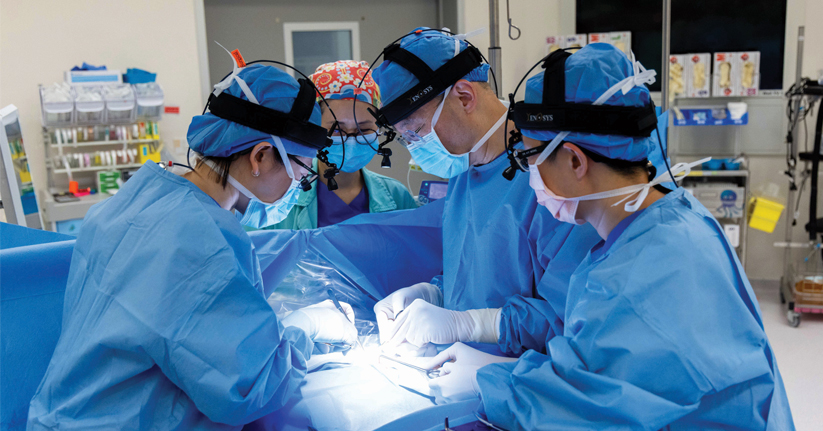《香港兒童醫院通訊》
新生兒手術 扭轉寶寶命運

一些寶寶甫出生時已命懸一線,急需接受手術。香港兒童醫院在2 0 2 4 / 2 5年度進行了全港公立醫院超過八成的新生兒手術。數字背後,是跨專科醫療團隊爭分奪秒為寶寶重燃希望的故事。
小兒外科部門主管譚煜謙醫生解釋:「嬰兒一出生便要做手術,可能是因為先天性消化系統畸形導致無法進食,像食道、腸道或肛門閉鎖,還有其他威脅到性命的情況,如先天性橫隔膜疝氣、壞死性腸炎等。」
心胸外科顧問醫生任力恒補充:「一些先天性心臟病,如嚴重主動脈狹窄和全肺靜脈連接異常可令嬰兒出現急性心臟衰竭,要盡快做開胸手術。我們也會為危重嬰兒接駁體外膜氧合器,支援心肺功能。」
精湛技術挽救弱小生命
為新生嬰兒做手術的醫生需具備專業技術。任醫生稱:「他們的體重可能只有數百克,心臟細小如一粒士多啤梨,血管結構很脆弱,所以手術每一步要非常精準,並採用專為嬰兒而設的器械。」麻醉及全期手術醫學科顧問醫生李秀民說:「嬰兒的呼吸和血壓容易波動,我們要密切監察其體溫、腦部供血量、含氧量、腦電波等指標,適時調校藥物及儀器。其中,心臟病嬰兒因各部位的血壓不一,要置入多條動脈導管作監察。」



譚醫生稱:「新生兒手術罕見複雜和變化多端,將它們集中在本院,有助外科醫生累積經驗和培訓,並與其他相關團隊建立默契。」
手術前後全方位照顧
完善的新生兒手術服務並不局限於手術室裏。各項配套必須環環相扣,才能提升病人安全和治療成效。本院與地區醫院的產科及新生兒深切治療部緊密聯繫。如發現孕婦的胎兒異常,可共同進行產前會診,預先制訂治療方案。當嬰兒一出世,便可盡快轉送至本院接受手術。
兒童及青少年科顧問醫生池月兒表示:「我們的重症治療運送團隊會前赴地區醫院運送嬰兒,在救護車上沿途監察,應付突發狀況。抵院前我們已可安排好放射檢查及手術室,做到無縫交接。曾有一名27周早產的腸穿嬰兒一到埗便直入新生兒深切治療部內的手術室,並順利進行緊急手術,最終獲救。」

手術後,嬰兒會在新生兒深切治療部密切監察。醫護人員要特別留意心肺功能及會否出現失溫、脫水和術後併發症,為他們提供適切治療,促進康復。院方更安排音樂治療師在床邊彈奏音樂,達到紓緩情緒、減痛、改善身體機能等作用。


另外,本院設有高危嬰兒計劃,由物理治療師、職業治療師、言語治療師和營養師跟進寶寶術後至出院後的身體發展,提供復康訓練。
初次啼聲的喜悅
「祐祐一出生便要插喉,當時我聽不到他的哭聲而感到害怕。但很幸運,他接受手術後漸漸好轉,最終脫離儀器,懂得自己呼吸,可以哭得出聲!他轉眼已七個月大,我們可以當他普通寶寶照顧,十分感謝醫護人員。」祐祐母親翁太雀躍地說。

祐祐產檢時被發現患有先天性橫隔膜疝氣,即橫隔膜穿了個洞,導致腸胃等器官移位至胸腔,阻礙肺部發育,可致心臟衰竭。為保住祐祐性命,威爾斯親王醫院婦產科及新生兒科與本院團隊進行聯合會診,決定先由婦產科醫生施行「胎兒鏡氣管閉塞術」,經子宮在胎兒氣管置入球囊,幫助其肺部發育。祐祐出生當日,立即由重症治療運送團隊護送至本院新生兒深切治療部,並使用強心藥及高頻呼吸機支援。
譚煜謙醫生稱:「祐祐一周後情況穩定下來我們便為他做手術,將器官復位及修補橫隔膜。因其橫隔膜的缺口較大,所以用了部份腹肌去填補,希望減少復發。」
在醫護人員悉心照顧下,祐祐逐步康復,一個多月後出院,與家人共度新春。對於這段有驚無險的經歷,翁生翁太滿懷感激:「醫生講解非常清晰,一切情況與預期吻合,讓我們安心;護士亦很專業,手勢純熟。」譚醫生說:「治療縱然艱苦,但家長不會獨自面對,醫護團隊會一直同行。」








